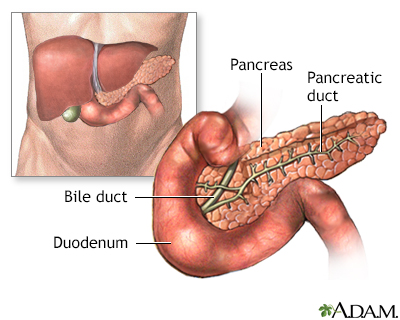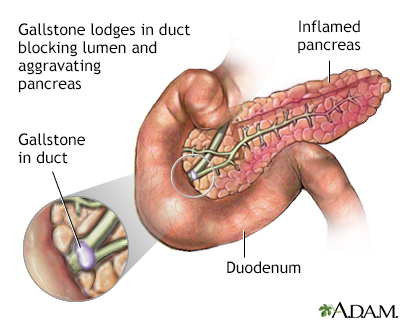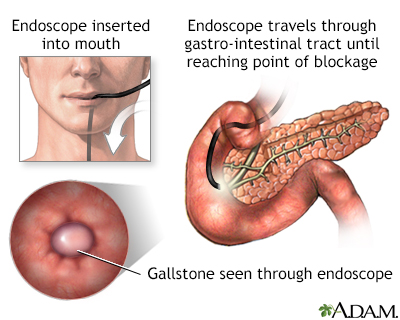Pancreatitis - series

Normal anatomy
The pancreas is located in the upper part of the abdomen, behind the stomach. It contains cells that secrete the hormone insulin, and cells that secrete digestive enzymes that aid in the breakdown of food in the gastrointestinal tract. The pancreas secretes these enzymes into the pancreatic duct, which joins the common bile duct from the liver and drains into the small intestine.

Indication
Inflammation of the pancreas, or pancreatitis, is a serious condition that is most commonly caused by either alcohol toxicity or gallstones.
Gallstones can lodge in the common bile duct and block the flow of pancreatic enzymes out of the pancreas into the intestine.
Pancreatitis due to alcohol toxicity is most often seen in people with alcohol use disorder. Most often, pancreatitis goes away with nonsurgical therapy. If a patient is too sick to eat by mouth, a feeding tube usually is placed to feed the gut as part of the treatment for acute pancreatitis. Also, pain medicine may be given to control the pain caused by pancreatic inflammation.

Procedure
If pancreatitis is due to gallstones, most often the responsible gallstone passes into the intestine spontaneously, and the pancreatitis goes away.
Less commonly, a minor surgical procedure is necessary to extract a gallstone that is blocking the pancreatic duct where it drains into the small intestine. An endoscope, with a camera on its end, is passed down the esophagus, through the stomach, and into the small intestine. The entrance of the pancreatic duct into the small intestine can be viewed through the endoscope. A special instrument on the end of the endoscope can then be passed into the pancreatic duct and the gallstone is extracted.
Very rarely pancreatitis is severe enough to require surgery, which is usually performed when the pancreas becomes infected. Dead pancreatic tissue is removed, and the area around the pancreas is washed clean. Patients who require such treatment usually have prolonged hospital stays and are seriously ill.
BACK TO TOP
Review Date: 10/30/2024
Reviewed By: Jenifer K. Lehrer, MD, Gastroenterologist, Philadelphia, PA. Review provided by VeriMed Healthcare Network. Also reviewed by David C. Dugdale, MD, Medical Director, Brenda Conaway, Editorial Director, and the A.D.A.M. Editorial team.

Health Content Provider
06/01/2025
|
A.D.A.M., Inc. is accredited by URAC, for Health Content Provider (www.urac.org). URAC's accreditation program is an independent audit to verify that A.D.A.M. follows rigorous standards of quality and accountability. A.D.A.M. is among the first to achieve this important distinction for online health information and services. Learn more about A.D.A.M.'s editorial policy, editorial process and privacy policy. A.D.A.M. is also a founding member of Hi-Ethics. This site complied with the HONcode standard for trustworthy health information from 1995 to 2022, after which HON (Health On the Net, a not-for-profit organization that promoted transparent and reliable health information online) was discontinued. |
The information provided herein should not be used during any medical emergency or for the diagnosis or treatment of any medical condition. A licensed medical professional should be consulted for diagnosis and treatment of any and all medical conditions. Links to other sites are provided for information only -- they do not constitute endorsements of those other sites. © 1997- 2025 A.D.A.M., a business unit of Ebix, Inc. Any duplication or distribution of the information contained herein is strictly prohibited.
